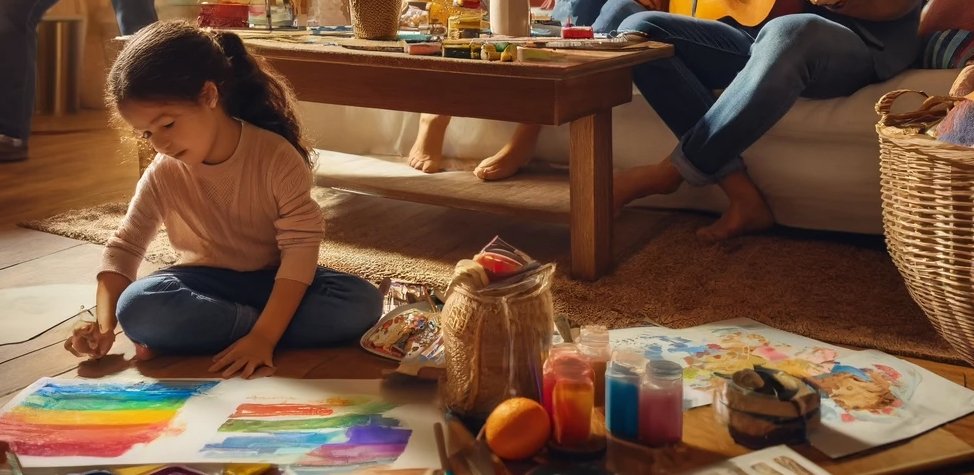
RESOURCES
Visual Arts Resources for Children & Parents
-

Process vs. Product Art
Did you know there were two ways to teach/do art with children? Learn about “Process Art vs. Product Art in Early Childhood Education” in this short video by “U-GRO Learning Centres”. Go to their blog to learn more about how to apply the concept.
-

A Brief History of Art Movements | Behind the Masterpiece
In this video, you'll see the evolution of art through the ages. A linear timeline filled with talented individuals over the years that always moves forward; towards something more, something new, something that excites a generation.
-

Evolution Of Art.
Another take on the history of art arises when we start discovering how it has shaped our world today! This more popular video by “La Volpe” entitled “The Evolution of Art (and how it Shaped the Modern World)” explains just how impactful this concept is. As we know: Art imitates Life… but what about visa versa?
-
Books & Other Texts
• "Studio Thinking 2: The Real Benefits of Visual Arts Education" by Lois Hetland, Ellen Winner, Shirley Veenema, and Kimberly M. Sheridan
• "The Art of Teaching Art: A Guide for Teaching and Learning the Foundations of Drawing-Based Art" by Deborah A. Rockman
• “Art Education in a Postmodern World: Collected Essays" edited by Tom Hardy
—Studio Thinking 2 summary: A book that explores the cognitive and developmental benefits of art education. Building on what was said in a previous installment, this book presents research findings that highlight how engaging in artistic processes fosters critical thinking, problem-solving skills, and deeper understanding in students. The authors discuss the development of artistic habits of mind, such as envisioning, observing, and reflecting, and how these habits contribute to enhanced learning experiences across different disciplines. Through case studies and practical examples, the book emphasizes the importance of integrating creative practices into education, emphasizing the value of art not only as a medium for self-expression but also as a powerful tool for cognitive development and skill-building.
—The Art of Teaching Art summary: A comprehensive guide that focuses on teaching drawing-based art fundamentals. This book is designed for art educators seeking to enhance their teaching methods and curriculum development in the realm of drawing. Delves into various aspects of teaching drawing, including curriculum design, instructional strategies, assessment techniques, and the incorporation of foundational skills. The book emphasizes the importance of cultivating both technical skills and conceptual understanding in students. It offers practical insights into structuring lessons, selecting appropriate materials, and guiding students through exercises that build their artistic capabilities. Provides numerous examples, instructional strategies, and classroom anecdotes to illustrate effective teaching practices. The aim is to equip educators with the tools to create a dynamic and engaging learning environment that encourages students to develop their artistic skills, hone their observational abilities, and deepen their artistic sensibilities. Serves as a valuable resource for art educators who wish to enhance their pedagogical approach to teaching drawing-based art, fostering an environment where students can build a strong foundation in artistic skills and concepts.
—Art Education in a Postmodern World summary: A compilation of essays that explore the evolving landscape of art education within the context of postmodernism. The book delves into the challenges and opportunities that art educators face in a world marked by cultural shifts, changing artistic paradigms, and the emergence of postmodern thought. The essays within the book critically examine how traditional approaches to art education are being reshaped and redefined by postmodern ideologies. They discuss how postmodernism challenges notions of authorship, representation, and the concept of the artist as an individual creator. The book also addresses the increasing interplay between diverse cultural perspectives and the impact of technology on art education. Through various theoretical discussions and practical examples, the essays emphasize the importance of incorporating a postmodern perspective into art education. This entails fostering critical thinking, encouraging students to question established norms, and embracing a broader array of artistic expressions and influences. Offers a thought-provoking exploration of the changing dynamics of art education in the postmodern era. It highlights the need for educators to adapt their approaches to align with contemporary artistic, cultural, and philosophical shifts, ultimately providing a deeper understanding of how art education can thrive in a rapidly evolving world.
-

Easy Origami
This Easy Origami Channel is all about the Art of Paper Folding. Basic Origami, Origami Tutorials, and Origami Lessons. Follow my Origami Videos and Step by Step Instructions and Lets Make Paper Art a Fun Thing For Children as Well as Adults. Learn how to make awesome Origami Models, from Simple to Complex!
-

Origami Art, Engineering…or Both?
How can one sheet of folding paper inform engineering and the future of space travel? Jinkyu “JK” Yang sees endless possibilities in a single sheet of paper. The aeronautics and astronautics professor at the University of Washington uses origami as a creative way to design foldable structures. The resulting shapes could inform new designs for a rocket’s landing gear, medical devices, or solar panels — all while pushing the boundaries of where art and science meet.
-

Tinkerlab
TinkerLab has easy and fun art activities that children and adults love – all in the spirit of exploration, experimentation, and play. There are free tools as well as other resources that are for purchase.

